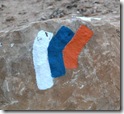One of the simultaneously best and worst experiences of my life was hiking the Israel Trail. I led a group of intrepid adventurers on a 120-mile hike, beginning in Dan and concluding in Caesarea  (skipping a 30-mile section in the middle). I’ve hiked many other portions of the trail over the years. The trail covers some of most beautiful and remote scenery, and it is a way to understand the land of Israel that you’ll never get from jumping on and off a bus. It also can be quite a painful experience for your feet.
(skipping a 30-mile section in the middle). I’ve hiked many other portions of the trail over the years. The trail covers some of most beautiful and remote scenery, and it is a way to understand the land of Israel that you’ll never get from jumping on and off a bus. It also can be quite a painful experience for your feet.
An Israeli couple recently hiked the entire trail from Eilat to Dan (580 miles) and the wife wrote a book about the 2-month trek. The book, Walk the Land, was recently reviewed by Theresa Newell of CMJ USA (pdf, p. 21). The review begins:
“What is needed by the reader or teacher of the Bible is some idea of the outlines of Palestine – its shape and disposition; its plains, passes and mountains; its rains, winds and temperatures; its colours, lights and shades. Students of the Bible desire to see a background and to feel an atmosphere; to discover from `the lie of the land’ why the history took certain lines and the prophecy and gospel were expressed in certain styles; to learn what geography has to contribute …” (From the 1894 Preface to the First Edition of The Historical Geography of the Holy Land, by George Adam Smith.)
Over a hundred years later, Judy Pex brings the reader through those very “plains, passes and mountains” about which Smith wrote. Step by step from Eilat to Mt. Hermon on The Israel Trail, Pex describes her country from the ground up.
Judy and John Pex have overseen The Shelter Hostel in Eilat for over 20 years. They lead an international congregation there which grew out of their work of serving soup dinners and giving backpackers a place for overnights. It is a 24/7 kind of job.
Their dream grew over the years: to walk the entire Israel National Trail (Shvil Israel) – a feat accomplished by only about 100 people per year. John decided it had to be done before his 60th birthday! And they did it – all winding 940 km (580 miles) from Eilat to Dan. The Trail meanders through the vast wadis and heights of the Negev, then cuts west to the Mediterranean near Tel Aviv along busy roads, up the coast and across the Carmel Range, ending on Mt. Hermon at the Syrian-Lebanese border. The map and 16 pages of Pex’s color photos augment her descriptive passages.
There is also an interview with the author here.
The book sounds like a profitable way to gain insights from the trip without having to wrap your feet in duct tape every morning.
HT: Yehuda Group